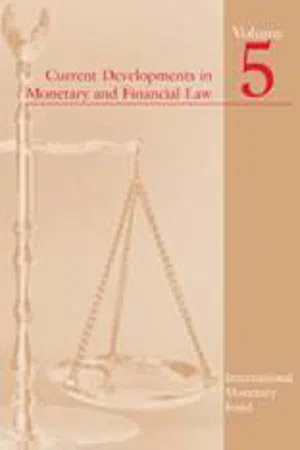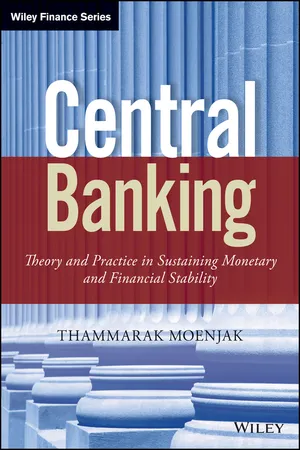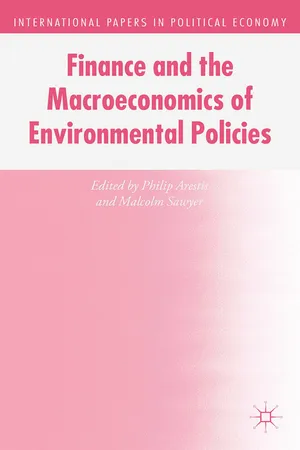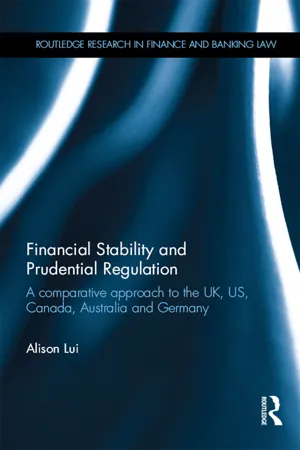Economics
Financial Stability
Financial stability refers to a state in which the financial system is resilient to shocks and able to perform its key functions effectively. It involves the ability of financial institutions to absorb and manage risks, as well as the smooth functioning of financial markets. Maintaining financial stability is crucial for promoting economic growth and preventing financial crises.
Written by Perlego with AI-assistance
Related key terms
Related key terms
1 of 4
Related key terms
1 of 3
6 Key excerpts on "Financial Stability"
- International Monetary Fund(Author)
- 2008(Publication Date)
- INTERNATIONAL MONETARY FUND(Publisher)
Second, Financial Stability is a broad concept, encompassing the different aspects of the financial system—infrastructure, institutions, and markets. Because of the interlinkages between these components, expectations of disturbances in any one component can affect overall stability, requiring a systemic perspective. Consistent with the definition of the financial system, at any given time, stability or instability could be the result of either private institutions and actions, or official institutions and actions, or both simultaneously and/or iteratively.Third, Financial Stability not only implies that the financial system adequately fulfills its role in allocating resources, transforming and managing risks, mobilizing savings, and facilitating wealth accumulation and growth, but also that within this system the system of payments throughout the economy functions smoothly (across official and private, retail and wholesale, and formal and informal payment mechanisms). This requires that money—both central bank money and its close substitute, derivative monies (such as demand deposits and other bank accounts)—adequately fulfills its role as a means of payment and unit of account and, when appropriate, as a short-term store of value. In other words, Financial Stability and what is usually regarded as a vital part of monetary stability overlap to a large extent. 14Fourth, Financial Stability requires the absence of financial crises and the ability of the financial system to limit and deal with the emergence of imbalances before they constitute a threat to stability. In a well-functioning and stable financial system, this occurs in part through self-corrective, market-disciplining mechanisms that create resilience and that endogenously prevent problems from festering and growing into system-wide risks. In this respect, there may be a policy choice between allowing market mechanisms to work to resolve potential difficulties and intervening quickly and effectively—through liquidity injections via markets, for example—to restore risk taking and/or to restore stability. Thus Financial Stability entails both preventive and remedial dimensions.- eBook - ePub
Central Banking
Theory and Practice in Sustaining Monetary and Financial Stability
- Thammarak Moenjak(Author)
- 2014(Publication Date)
- Wiley(Publisher)
8These diverse emphases in defining Financial Stability suggest that Financial Stability is indeed multifaceted in nature, and that one has to look at the interaction of various facets to get a more complete picture.10.2 A PRACTICAL ANALYTICAL FRAMEWORK: THE MACROECONOMY, FINANCIAL INSTITUTIONS, AND FINANCIAL MARKETS
It might be helpful to recognize that Financial Stability encompasses three key interrelated elements for central banks: (1) a macroeconomy that is free of major financial imbalances, (2) a system of financial institutions that is sound and stable, and (3) financial markets that are smoothly functioning. These three elements of Financial Stability normally interact with each other in a state of flux, and the absence of any one element can lead to financial instability as well as the failure of the other two elements.b Figure 10.1 illustrates the overlapping dimensions of the three key elements of Financial Stability.FIGURE 10.1 Overlapping Dimensions of Financial Stability: The Macroeconomy, Financial Institutions, and Financial MarketsAn analytical framework based on recognizing the three key elements and their interrelationships is practical from the central bank’s vantage point for at least three reasons. First, it helps disentangle the inherent complexity of the interrelationships among the key elements of Financial Stability into more tractable and manageable parts. Second, it corresponds well with the institutional setup of most modern central banks, even those without supervisory function. Third, it corresponds well to the disparate body of theoretical and empirical research on the issues related to Financial Stability that can also be grouped roughly into these three specific areas (see Gertler’s 1988 paper, for example).9 - eBook - ePub
Role Of Central Banks In Financial Stability, The: How Has It Changed?
How Has It Changed?
- Douglas D Evanoff, Cornelia Holthausen, George G Kaufman, Manfred Kremer(Authors)
- 2013(Publication Date)
- WSPC(Publisher)
* Nellie Liang is the director of the Office of Financial Stability Policy and Research, Board of Governors of the Federal Reserve System. The views presented here are the author’s and do not necessarily reflect those of the Board of Governors or its staff. The author thanks Tobias Adrian, Jim Clouse, Dan Covitz, Bill English, Mike Gibson, Andrea Kusko, Andreas Lehnert, and Mark Vanderweide for helpful comments, and Valentin Bolotnyy and Steven Hopper for excellent research assistance.1 This paper is based on remarks delivered at the Fourteenth Annual International Banking Conference at the Federal Reserve Bank of Chicago on November 10, 2011.2 See Woodford (2011).3 See Caballero (2010) and Cochrane (2010) for differing views.4 Regardless of one’s view on the appropriate weight to attach to moral hazard, some recent research suggests that the lender of last resort cannot commit to withhold liquidity ex post, even if it would reduce incentives for excessive risk-taking, primarily because leverage building is a strategic complement among firms. See Farthi and Tirole (2009).5 See Kohn (2011).6 For example, Goodfriend (2011) has proposed an agreement similar to the 1951 Treasury-Fed accord.7 The Role of the Federal Reserve in Preserving Financial and Monetary Stability; see www.federalreserve.gov/newsevents/press/monetary/20090323b.htm .Passage contains an image
Role of Central Banks in Financial Stability:Lessons from the Experience of the Bank of Japan1. IntroductionTakeo Hoshi*Stanford University, NBER, and TCERRosengren (2011) defines Financial Stability as the “ability of the financial system to consistently supply the credit intermediation and payment services that are needed in the real economy if it is to continue on its growth path.” Thus, Financial Stability is lost when the financial system fails to provide the services and harms the real economy. It is important to note that turmoil in the financial system that accompanies failures of financial institutions does not necessarily jeopardize the Financial Stability. For example, a large number of savings and loan institutions failed in the 1980s U.S., but other financial institutions were able to step up and increase financial intermediation without serious impact on the real economy, as Rosengren points out. - eBook - ePub
- Marian Noga, Konrad Raczkowski, Jaros?aw Klepacki, Jaros?aw Klepacki(Authors)
- 2015(Publication Date)
- Palgrave Macmillan(Publisher)
3 Management of Financial Stability RiskIntroductionA record number of organizations -governmental, commercial/nongovernmental - are currently dealing with the management of Financial Stability risk, especially in the sector of economies and financial markets. The issue has become so popular nowadays that it might seem boring and overrated. On the contrary, it is still a very underdefined process. It is difficult to successfully manage something, if in fact one does not exactly know what it is. There is no consistent and generally accepted definition of risk. Acts of law do not provide a clear statutory definition of what risk involved in Financial Stability is either. The definitions that have been provided are very general in nature. There is even a problem with developing an accurate definition of such seemingly prosaic risk as legal risk.The management processes in operation now are mainly based on the latest experiences (from the most recent years), that is, the consequences of the economic crisis initiated by a crash on the financial markets in August 2008 and the collapse of Lehman Brothers Bank.It is becoming more and more obvious that the management of Financial Stability risk is assuming a completely new importance. At first, it was a local phenomenon typical for processes occurring at the beginning of the first half of the 20th century, and then it transformed into a chain of global events that can be seen now. The perception of risk has also evolved. From an underrated, underestimated, and underdefined thing concentrated mainly on statistical and mathematical assumptions, it transformed into a phenomenon observed in more and more contexts, having a global scale, and influenced by strong behavioral factors. The attitude toward the process of management itself has changed as well. It used to be passive and of rather secondary importance, and now it is extremely active and not oriented at all toward the elusive elimination or neutralization but rather the efficient diversification of risk and the maximum limitation of of its negative consequences. - P. Arestis, M. Sawyer, P. Arestis, M. Sawyer(Authors)
- 2015(Publication Date)
- Palgrave Macmillan(Publisher)
The period of financial liberalisation since circa 1970 appears to have exacerbated the numbers, though, of course, there are many examples of pre-1970 crisis. However, as hinted in the section above on the circuitist approach, there appear to be inherent features of the banking and financial system which tend to generate financial instability, credit booms and busts, and so on, and that whilst measures of regulation and structure of the financial system can be adopted which reduces those tendencies, nevertheless they remain. ‘The financial instability hypothesis is a model of a capitalist economy which does not rely upon exogenous shocks to generate business cycles of varying severity: the hypothesis contend that business cycles of history are compounded out of the internal dynamics of capitalist economies as well as out of the system interventions and regulations designed to keep the economy operating within reasonable bounds’ (Minsky, 1994, p. 157).In order to think about the robust banking and financial system, it is helpful to consider what the sources of instability can be, and hence what design measures would aid the reduction of such instability.At a general level, the requirement is for a banking and financial system which serves the rest of the economy rather than the rest of the economy serving the interests of the financial sector. Apart from the provision of a well-functioning payments technology, the key requirements which should be made for a financial system are that:i. it expands in a way which is consistent with the environmentally sustainable rate of growth; ii. it channels savings into the social desirable types of investment.The first part of that includes seeking to construct a stable banking and financial system. A more significant element is that the financing of investment, initial and final in the terminology of the circuit approach, is channelled towards socially desirable and environmentally friendly investment, and not towards financial asset accumulation speculation. A similar thought applies to the second part. It also indicates, however, that the thrust of the operations of the banking and financial system should be on the financing and funding of real investment, and not financial investments, rather than be engaged in securitisation, derivatives, and so on.- eBook - ePub
Financial Stability and Prudential Regulation
A Comparative Approach to the UK, US, Canada, Australia and Germany
- Alison Lui(Author)
- 2016(Publication Date)
- Routledge(Publisher)
Modern central banks are primarily occupied with monetary-policy matters (Bank for International Settlements 2009) since confidence in price stability and the currency is crucial for a healthy economy. With time, the combination of economic crises, wars and the breakdown of the gold standard transformed central banks from government banks into public agencies. This shift to a public-policy dimension meant that central banks are now working towards the interests of the financial system as a whole, rather than for commercial objectives. Like most concepts in finance, Financial Stability is not absolute and it changes with time. It has many facets, embracing rule-making, policy development and supervision. The lender-of-last-resort role is a way for central banks to sustain Financial Stability by assisting individual banks rather than monitoring liquidity for the general financial system. In exceptional circumstances such as the global financial crisis, the general liquidity and specific liquidity lending under the lender-of-last-resort principle merge. It is interesting to note that only 20 per cent of the 146 central banks have express objectives for Financial Stability and that around 50 per cent of the world’s central banks have more generic objectives regarding Financial Stability. Since the global financial crisis, the Reserve Bank of Australia, Federal Reserve, Bank of Canada, Bank of England and ECB have all had the wide objective of promoting, enhancing and contributing to Financial Stability. Macro-prudential regulation and supervision contribute to Financial Stability by involving the relevant regulatory authority in monitoring systemic risks holistically. Effective central-bank regulation is of practical importance because it can affect the quality of bank regulation and supervision (Koetter et al. 2014). The ultimate aim of macro-prudential regulation is to avoid macro-economic costs linked to Financial Stability (Galati and Moessner 2010)
Index pages curate the most relevant extracts from our library of academic textbooks. They’ve been created using an in-house natural language model (NLM), each adding context and meaning to key research topics.
Explore more topic indexes
Explore more topic indexes
1 of 6
Explore more topic indexes
1 of 4





